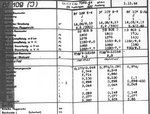Hello HoHun
Quote:" At ranges out to 250 m, gravity drop hardly matters anyway."
I don't have info on gravity drop of MK108 (mv 505m/s for Minen) but the gravity drop for MG151/20 (mv 800m/s for Minen) was 100cm at 280m. IMHO that of MK108 should be larger.
Quote:" Nevertheless, the typical kill ranges were below "true" 250 m, not "perceived" 250 m."
Now IMHO the typical firing ranges is at least as interesting as the typical kill ranges, maybe even more so because it's entirely possible that most burst fired in dogfight missed and it's at least as interesting to know why a burst miss as why it hit. And higher mv usually meant flatter flight path and shorter flying time, both of which tended to lessen the effects of errors in sighting (for ex. in estimated range and lead and maybe even lesser extent errors in flying (for ex. skid and slip).
I agree that nose armament has inherent advantages vs wing armament, especially because dispersion is much less dependent on range.
Juha
Quote:" At ranges out to 250 m, gravity drop hardly matters anyway."
I don't have info on gravity drop of MK108 (mv 505m/s for Minen) but the gravity drop for MG151/20 (mv 800m/s for Minen) was 100cm at 280m. IMHO that of MK108 should be larger.
Quote:" Nevertheless, the typical kill ranges were below "true" 250 m, not "perceived" 250 m."
Now IMHO the typical firing ranges is at least as interesting as the typical kill ranges, maybe even more so because it's entirely possible that most burst fired in dogfight missed and it's at least as interesting to know why a burst miss as why it hit. And higher mv usually meant flatter flight path and shorter flying time, both of which tended to lessen the effects of errors in sighting (for ex. in estimated range and lead and maybe even lesser extent errors in flying (for ex. skid and slip).
I agree that nose armament has inherent advantages vs wing armament, especially because dispersion is much less dependent on range.
Juha



